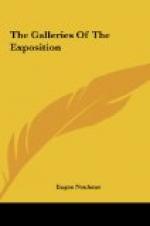Gallery 72.
There seems no end of productiveness of American painters, and justice demands more investigation and undeniably more steps. Ladies with parrots, with and without clothes, are numerous, but the one in here is more interesting than the others. I hope that not all of these parrot pictures are meant symbolically. Walter McEwen arouses memories of times gone by, technically and otherwise, in a huge storytelling Salon picture. More ladies in conventional sitting posture willingly sat for more pictures without adding new thrills. Meyer’s portraits, Gertrude Fiske’s sketch, Olga Ackerman’s group of children, are all deserving of study. Max Bohm’s two big figural pictures are decoratively interesting enough, but bad in paint. One of the best landscapes can be found here in Henry Muhrman’s work, over the McEwen. There is nothing sensational about it, but its somber dignity stands out among many modern works. On the opposite wall Mrs. Sargent’s” Mount Tamalpais” is unusual in composition and rich in colour.
Separated from the rest of the American section by Holland and Sweden, a series of galleries are in grave danger of being overlooked. Undoubtedly, to offset this apparent isolation, some of the most alluring paintings can be found at this end.
Gallery 117.
Here is Frederic Frieseke, our expatriated American, with his fascinating boudoir scenes. Very high in key and full of detail, at first they seem restless and crowded, which some actually are, in a degree. But canvases like “The Garden” and “The Bay Window” and “The Boudoir” are real jewels of light and colour. “The Bay Window” is the most placid of his canvases and in conception much finer than his outdoor subjects. Frieseke’s clear, joyous art is typically modern, and expresses the best tendency of our day. Luis Mora’s two watercolours, while illustrative, hold their own in Frieseke’s company. Tanner’s big religious canvas falls far below this capable painter’s usual efforts. Native talent helps out in a delightful marine, honestly painted by Bruce Nelson, and an apple green and pale pink colour-harmony by Charlton Fortune. Very much in the style of the Frieseke, Rittman’s “Early Morning in the Garden” is easily taken for the art of his fascinating neighbor, but it should be recognized as the work 0f another kindred spirit.
Gallery 118.
In 118, landscapes predominate over figural work, at least in quality. Harry Leslie Hoffman’s “Spring Mood,” Wilbur Dean Hamilton’s tender and poetic canvas, and Louise Brumbach’s city view bathed in the grays of an early morning call for recognition.
Gallery 119.
The general character of the next gallery is different from the preceding. Given over to oils, watercolours, pastels, lithographs, and drawings, it presents an interesting appearance. Six pastels by Henry Muhrman and Frank Mura’s charcoal drawings are the leaders here, and the drawings generally are the best things among the many oils and watercolours, which were mostly made for purposes of illustration. Drawings by Martinez, pastels by Miss Percy, two sympathetic drawings by Miss Hunter, and a few still-lifes in watercolour, by Miss Boone, all bear testimony to native ability as represented by California.




